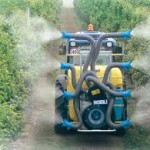![]() During my entire 34-year career as a Pest Control Adviser I have recommended the use of pesticides on a “per acre” basis and the growers have applied them on a “per acre” basis. At the annual Farm Safety Day I teach a class on how to calibrate spray rigs, and on occasion astute growers have pointed out that this practice doesn’t really make sense. I have readily agreed with them. In fact, entire countries, having realized this, have abandoned the practice! I think the time has come for us to take a closer look at our use of “per acre” spray calibration.
During my entire 34-year career as a Pest Control Adviser I have recommended the use of pesticides on a “per acre” basis and the growers have applied them on a “per acre” basis. At the annual Farm Safety Day I teach a class on how to calibrate spray rigs, and on occasion astute growers have pointed out that this practice doesn’t really make sense. I have readily agreed with them. In fact, entire countries, having realized this, have abandoned the practice! I think the time has come for us to take a closer look at our use of “per acre” spray calibration.
There are 43,560 square feet in an acre and if we were spraying alfalfa then we would be spraying all 43,560 square feet, but we’re not. We are spraying vineyard rows, and the amount of vineyard row in an acre depends on the space between the rows. If a vineyard is planted with 12 feet between the rows then an acre consists of 3,630 linear feet of vineyard row per acre. However, if a vineyard is planted with 9 feet between the rows then an acre consists of 4,840 linear feet of vineyard row per acre.
A highly effective and fairly expensive miticide used by some Lodi growers is Acramite 50WS. The label calls for a dose of .75 to 1.0 pounds per acre. If you apply .75 pounds per acre in a vineyard with 12 feet between
the rows then you are applying .75 pounds per 3,630 linear feet of vineyard row. Another way to say this is that you are applying 3.3 ounces of Acramite per 1,000 feet of vineyard row.

Now let’s imagine that you are applying 1.0 pounds of Acramite per acre in a vineyard with 9 feet between the rows. That means that you are applying 1.0 pounds per 4,840 linear feet of vineyard row. Another way to say this is that you are applying 3.3 ounces of Acramite per 1,000 feet of vineyard row.
In one vineyard you applied Acramite at the low end of the label rate and in the other vineyard you applied it at the high end of the label rate. However, in each case you applied 3.3 ounces per 1,000 linear feet of vineyard row. In other words, although your per acre doses were completely different, the actual dose arriving on the grapevine canopy was exactly the same.
This is the new math: .75 pounds equals 1.0 pounds! Or at least it can, depending on the row spacing. This is important because research trial results are reported based on a certain pesticide dose per acre. However, if you don’t know the row spacing of the vineyard where the trial was conducted then you don’t know how much pesticide was actually applied per 1,000 feet of vineyard row. If we are going to continue to talk in terms of “per acre” doses then we always need to know the row spacing in the vineyard where the research was conducted. Either that, or the research needs to be reported in terms of linear feet of vineyard row rather than on a “per acre” basis. The same logic applies to sales or technical presentations in which pesticide doses are reported on a “per acre” basis.
When we talk about “per acre” pesticide doses we are talking in terms of area based calibration and our unit of measure is the acre. When we talk about “per 1,000 feet of vineyard row” pesticide doses then we are talking
in terms of distance based calibration and our unit of measure can be any measurement of distance. If we are going to farm vineyards with different row spacings then distance based calibration makes much more sense than area based calibration.

There is still more to this new math. It is also true that 1,000 linear feet of vineyard row are not always equal to 1,000 linear feet of vineyard row. Imagine a vertically shoot positioned vineyard in Sonoma in May and a vineyard on a quadrilateral trellis in Madera in July. The canopy sizes are completely different! That 1,000 feet of vineyard row in Madera will have much more canopy to cover than the VSP vineyard in Sonoma. In addition to distance we also need to adjust our calibration to compensate for the size of the canopy.
The details of how to do distance based calibration, including how to adjust for canopy size, are clearly explained in the book Orchard & Vineyard Spraying Handbook for Australia & New Zealand by Geoffrey O. Furness which is available at the U.C. Davis bookstore. According to Mr. Furness both Australia and New Zealand have switched from area based calibration to distance based calibration in their vineyards.
If we want to make a similar transition it will not be simple, quick or easy. All of our pesticide labels are written with per acre doses and it is a violation of state and federal law to deviate from the label. In addition, our
pesticide use reporting procedures are all based on per acre doses, as are our spray rig calibration practices. Although we cannot make the transition immediately, I think it is important for each of us to begin to realize that in modern California vineyards the use of area based calibration no longer makes rational sense. The transition to distance based calibration is inevitable and in my opinion the sooner the better.
In my next posting, which will be published in January, I will discuss how to prevent powdery mildew in Chardonnay vineyards.
Thanks for reading. I’m happy to discuss my Coffee Shop posts with you, address any comments and answer any questions you may have. I can be contacted by email at lrwhitted@aol.com or by phone at (209) 327-6472. You can read more about me in this previous post.

